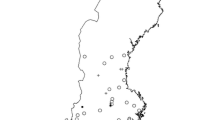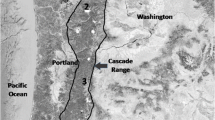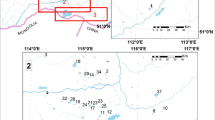Abstract
Experimental acidification of a softwater lake to below pH 5 fundamentally changed the sulfur cycle and lowered internal alkalinity generation (IAG). Prior to reaching pH 4.5, the balance of sulfur reduction and oxidation reactions within the lake was in favour of reduction, and the lake was a net sink for sulfate. In the four years at pH 4.5 the balance of reduction and oxidation reactions was in favour of oxidation, and there was a net production of sulfate (SO4 2−) within the lake. Evidence indicating a decrease in net SO4 2− reduction at pH 4.5 was also obtained in an anthropogenically acidified lake that had been acidified for many decades. In both lakes, the decrease in net SO4 2− reduction appeared to be linked not to a simple inhibition of SO4 2− reduction but rather to changes in benthic ecosystem structure, especially the development of metaphytic filamentous green algae, which altered the balance between SO4 2− reduction and sulfur oxidation.
At pH's above 4.5, net SO4 2− reduction was the major contributor to IAG in the experimental lake, as it is in many previously studied lakes at pH 5 and above. At pH 4.5, the change in net annual SO4 2− reduction (a decrease of 110%) resulted in a 38% decrease in total IAG. Because of the important role of net SO4 2− reduction in acid neutralization in softwater lakes, models for predicting acidification and recovery of lakes may need to be modified for lakes acidified to pH <5.
Similar content being viewed by others
References
Amaral JA (1991) Sulfate reduction and organic sulfur formation in lake sediments. Ph.D. Thesis, U. of Manitoba, 255 pp
Anderson RF & Schiff S (1987) Alkalinity generation and the fate of sulfur in lake sediments. Can. J. Fish. Aquat. Sci. (Suppl. 1) 44: 188–193
Baker LA, Brezonik PL & Pollman CD (1986) Model of internal alkalinity generation: sulfate retention component. Water Air Soil Polln 31: 89–94
Baker LA & Brezonik PL (1988) Dynamic model of in-lake alkalinity generation. Water Resources Research 24: 65–74
Baker LA, Pollman CD & Eilers JM (1988) Alkalinity regulation in softwater Florida lakes. Water Resources Research 24: 1069–1082
Baker LA, Urban NR, Brezonik PL & Sherman LA (1989) Sulfur cycling in an experimentally acidified seepage lake. In: Saltzman ES & Cooper WJ (Eds) Biogenic Sulfur in the Environment (pp 79–100). American Chemical Society, Washington DC, USA
Cook RB & Kelly CA (1991) Sulphur cycling and fluxes in temperate dimictic lakes. In: Howarth RW, Stewart JWB & Ivanov MV (Eds) Sulphur Cycling on the Continents, SCOPE 48, John Wiley & Sons, Pub
Cook RB & Schindler DW (1983) The biogeochemistry of sulfur in an experimentally acidified lake. Env. Biogeochem. Ecol. Bull. (Stockholm) 35: 115–127
Cook RB, Kelly CA, Schindler DW & Turner MA (1986) Mechanisms of hydrogen ion neutralization in an experimentally acidified lake. Limnol. Oceanogr. 31: 134–148
Giblin AE, Likens GE, White D & Howarth RW (1990) Sulfur storage and alkalinity generation in New England lake sediments. Limnol. Oceanogr. 35: 852–869
Henriksen A & Brakke DF (1988) Increasing contributions of nitrogen to the acidity of surface waters in Norway. Water, Air, Soil Pollut. 42: 182–201
Herlihy AT & Mills AL (1986) The pH regime of sediments underlying acidified waters. Biogeochemistry 2: 95–99
Hesslein RH (1976) An in situ sampler for close interval porewater studies. Limnol. Oceanogr. 21: 912–914
Howell ET, Turner MA, France RL, Jackson MB & Stokes PM (1990) Comparison of Zygnematacean (Chlorophyta) algae in the metaphyton of two acidic lakes. Can. J. Fish. Aquat. Sci. 47: 1085–1092
Kelly CA, Rudd JWM, Cook RB & Schindler DW (1982) The potential importance of bacterial processes in regulating rate of lake acidification. Limnol. Oceanogr. 27: 868–882
Kelly CA & Rudd JWM (1984) Epilimnetic sulfate reduction and its relationship to lake acidification. Biogeochemistry 1: 63–77
Kelly CA, Rudd JWM, Furutani A & Schindler DW (1984) Effects of lake acidification on rates of organic matter decomposition in sediments. Limnol. Oceanogr. 29: 687–694
Kelly CA, Rudd JWM, Hesslein RH, Schindler DW, Dillon PJ, Driscoll CT, Gherini SA & Hecky RE (1987) Prediction of biological acid neutralization in acid-sensitive lakes. Biogeochemistry 3: 129–140
Kelly CA, Rudd JWM & Schindler DW (1990) Acidification by nitric acid — future considerations. Water Air Soil Polln. 50: 49–61
Kling GW, Giblin AE, Fry B & Peterson BJ (1991) The role of seasonal turnover in lake alkalinity dynamics. Limnol. Oceanogr. 36: 106–122
Kuivala KM & Murray JW (1984) Organic matter diagenesis in freshwater sediments: the alkalinity and total CO2 balance and methane production in the sediments of Lake Washington. Limnol. Oceanogr. 29: 1218–1230
McKinley VL & Vestal JR (1982) Effects of acid on plant litter decomposition in an arctic lake. Appl. Environ. Microbiol. 43: 1188–1195
Paetilae A (1986) Survey of acidification by airborne pollutants in 52 lakes in southern Finland. Aqua Fenn 16: 203–210
Rudd JWM, Kelly CA & Furutani A (1986a) The role of sulfate reduction in long term accumulation of organic and inorganic sulfur in lake sediments. Limnol. Oceanogr. 31: 1281–1291
Rudd JWM, Kelly CA, St. Louis V, Hesslein RH, Furutani A & Holoka MH (1986b) Microbial consumption of nitric and sulfuric acids in acidified north temperate lakes. Limnol. Oceanogr. 31: 1267–1280
Rudd JWM, Kelly CA, Schindler DW & Turner MA (1988) Disruption of the nitrogen cycle in acidified lakes. Science 240: 1515–1517
Rudd JWM, Kelly CA, Schindler DW & Turner MA (1990) A comparison of the acidification efficiencies of nitric and sulfuric acids by two whole-lake addition experiments. Limnol. Oceanogr. 35: 663–679
Sampson CJ, Brezonik PL & Weir EP (1994) Effects of acidification on chemical composition and chemical cycles in a seepage lake: inferences from a whole-lake experiment. In: Baker LA (Ed) Environmental Chemistry of Lakes and Reservoirs (pp 121–159). Adv. Chem. Ser. ACS
Schiff SL & Anderson RF (1987) Limnocorral studies of chemical and biological acid neutralization in two freshwater lakes. Can. J. Fish. Aquat. Sci. 44: 173–187
Schindler DW Wagemann R, Cook RB, Ruszczyunski T & Prokopovich J (1980) Experimental acidification of Lake 223, Experimental Lakes Area: Background data and the first three years of acidification. Can. J. Fish. Aquat. Sci. 37: 342–354
Schindler DW (1986) The significance of in-lake production of alkalinity. Water, Air, Soil Polln. 30: 931–944
Schindler DW, Turner MA, Stainton MP & Linsey GA (1986) Natural sources of acid neutralizing capacity in low alkalinity lakes of the Precambrian Shield. Science 232: 844–847
Schindler DW (1990) Experimental whole lake perturbations as tests of ecosystem theory. Oikos 57: 25–41
Schindler DW et al. (1991) Comparisons between experimentally- and atmospherically-acidified lakes during stress and recovery. Proc. Royal Soc. Edinburgh 97B: 193–226
Sherman LA, Baker LA, Weir EP & Brezonik PL (1994) Sediment porewater dynamics of Little Rock Lake, Wisconsin: Geochemical processes and seasonal and spatial variability. Limnol. Oceanog. 39: 1155–1171
Stainton MP, Capel MJ & Armstrong FAJ (1977) The chemical analysis of fresh water. 2nd Ed. Can. Fish. Mar. Serv. Misc. Spec. Pub. 25
Sweerts J-P, Rudd JWM & Kelly CA (1986) Metabolic activities in flocculent surface sediments and underlying sandy littoral sediments. Limnol. Oceanogr. 31: 330–338
Turner MA, Jackson MB, Findlay DL, Graham RW, De Bruyn ER & Vandermeer EM (1987) Early responses of periphyton to experimental lake acidification. Can. J. Fish. Aquat. Sci. 44 (Suppl. 1): 135–149
Turner MA, Howell ET, Summerby M, Hesslein RH, Findlay D & Jackson M (1991) Changes in epilithon and epiphyton associated with experimental acidification of a lake to pH 5. Limnol. Oceanogr. 36: 1390–1405
Wei Y-X, Yung Y-K, Jackson MB & Sawa T (1989) Some Zygnemataceae (Chlorophyta) of Ontario, Canada, including descriptions of two new species. Can. J. Bot. 67: 3233–3247
Wright RW (1985) Chemistry of Lake Hovvatn, Norway, following liming and reacidification. Can. J. Fish. Aquat. Sci. 42: 1103
Author information
Authors and Affiliations
Rights and permissions
About this article
Cite this article
Kelly, C.A., Amaral, J.A., Turner, M.A. et al. Disruption of sulfur cycling and acid neutralization in lakes at low pH. Biogeochemistry 28, 115–130 (1995). https://doi.org/10.1007/BF02180680
Received:
Accepted:
Issue Date:
DOI: https://doi.org/10.1007/BF02180680




